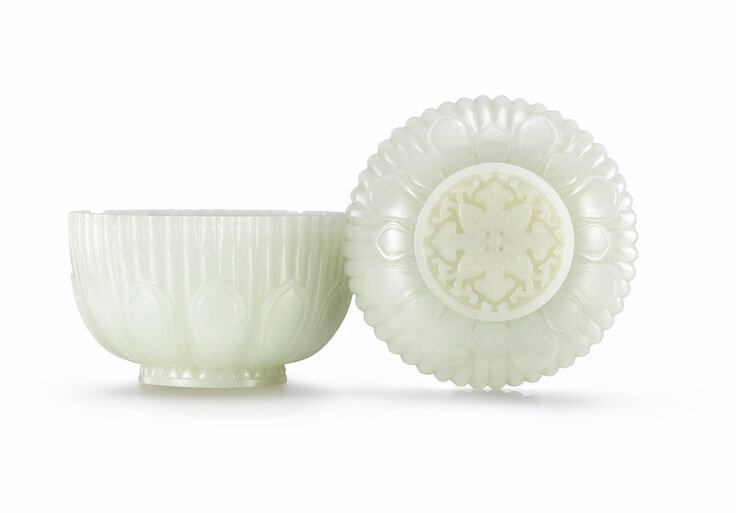A white jade ‘Chrysanthemum and Lotus’ bowl and cover, Qing Dynasty, Qianlong Period (1736-1795)
Lot 3677. A white jade ‘Chrysanthemum and Lotus’ bowl and cover, Qing Dynasty, Qianlong Period (1736-1795); ; 10.8 cm, 4 5/8 in. Estimate 2,200,000 — 3,000,000 HKD. Lot Sold 5,680,000 HKD. Photo: Sotheby’s.
the deep rounded sides carved in the form of a floral bloom with thin lobed sides extending onto the splayed foot, interrupted by a band of lotus petal lappets encircling the body, the interior centred in low relief with a floret surrounded by stylised mallow petals, the well-fitted cover similarly carved with lobed sides and surmounted by a circular flat-topped finial with a stylised floral medallion, the translucent stone of an attractive white colour with faint white veining.
Provenance: De Baecque Ventes aux Enchères, 1984, lot 27.
Note: This bowl and cover is impressive for the high quality stone from which it has been delicately fashioned, which has been highlighted by the restrained carving and exquisitely finished surface. Flawless with an even hue, the present stone most probably came from the jade-rich territories of Khotan and Yarkand, areas opened after the Qing army’s conquest of the north-western territories. Jade imported from this Central Asian region was of the highest quality, thus allowing carvers to produce wares of the purest and brightest white colouration.
Jade vessels fashioned in the form of chrysanthemum flowers are a Qianlong innovation, and derived from Song dynasty lacquer prototypes that were finely reproduced in porcelain under the Yongzheng emperor in a range of colours. With its newfound access to exceptional quality jade boulders in the Qianlong period, the craftsmen reinterpreted the elegant form in the treasured medium. A related bowl and cover, but the knop described as carved with a shou character framed by lingzhifungus, is illustrated in Stanley C. Nott, Chinese Jades in the Stanley Charles Nott Collection, London, 1942, pl. LXV, no. 55; and another, supported on a ruyi foot and surmounted with a pierced interlinking ruyi knop, was sold in our New York rooms, 22nd March 2007, lot 131.
The petal lappets encircling the foot of the bowl and knop of the cover are reminiscent of a pair cloisonné enamel boxes with a Jingtai mark and of the period (1450-1456), one in the National Palace Museum, Taipei, illustrated in Enamel Ware in the Ming and Ch’ing Dynasties, Taipei, 1999, pl. 1 and front cover; and the other, from the collections of T.B. Kitson and Mr and Mrs A.S. de Breyne, sold in our London rooms, 21st February 1961, lot 277, and again at Christie’s Hong Kong, 28th October 2002, lot 612. The rare Jingtai box is similarly cast with raised lotus petals which radiate from a lotus seed pod medallion that resembles that found on the interior of the present bowl. Both the Jingtai and Qianlong emperors are known to have been genuine practitioners of Tibetan Buddhism, and the four-point vajra carved on the knop of this piece further supports the Tibetan influence of the present piece. Compare a jade bowl and cover, carved with broad raised lotus petals and a lotus flower finial, Christie’s London, 11th May 2010, lot 89.
Sotheby’s. Fine Chinese Ceramics and Works of Art, Hong Kong, 08 oct. 2014

/https%3A%2F%2Fprofilepics.canalblog.com%2Fprofilepics%2F1%2F0%2F100183.jpg)
/https%3A%2F%2Fstorage.canalblog.com%2F03%2F02%2F119589%2F96711876_o.jpg)
/https%3A%2F%2Fstorage.canalblog.com%2F11%2F31%2F119589%2F94773502_o.jpg)
/https%3A%2F%2Fstorage.canalblog.com%2F20%2F83%2F119589%2F94772815_o.jpg)
/https%3A%2F%2Fstorage.canalblog.com%2F26%2F72%2F119589%2F75604929_o.jpg)
/https%3A%2F%2Fstorage.canalblog.com%2F59%2F60%2F119589%2F26458628_o.jpg)



/image%2F1371349%2F20240406%2Fob_a54acc_435229368-1644755382961141-18285727260.jpg)
/image%2F1371349%2F20240229%2Fob_b1ea4c_429582962-1625285201574826-43586635599.jpg)
/image%2F1371349%2F20240229%2Fob_84bc3b_429558450-1624783464958333-37673404077.jpg)
/http%3A%2F%2Fstorage.canalblog.com%2F36%2F88%2F119589%2F129555285_o.jpg)